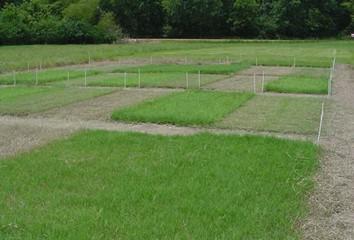
Credit: John Read
When fertilizing bermudagrass with poultry litter, turfgrass managers must consider limiting the buildup of soil P or drawing down soil test P through cut-and-carry forage. In a previous study that provided turfgrass with 122 kg ha-1 P in poultry litter, researchers found that Tifton 44 bermudagrass cut every 49 days at 3-cm stubble height recovered 23% of the P applied. Bermudagrass P removal is closely associated with dry matter (DM) yield and can be altered through management variables like variety, plant maturity at harvest, and litter application rate or timing. Given the tradeoff between DM yield and the amounts of crude protein and digestible DM in bermudagrass, managing harvests to maximize P recovery may adversely impact forage nutritive value.
In an article recently published in Crop, Forage & Turfgrass Management, researchers report on the response of forage nutritive value and P removal to the combined effects of harvest interval and stubble height in Russell and Tifton 44 bermudagrass receiving 4 tons acre-1 of poultry litter supplemented with 98 lb acre-1 N each spring from 2005 to 2007. Soil test P increased by approximately 60 mg kg-1, but there was no difference in soil P accumulation in the harvest interval x stubble height plots in autumn 2007. They concluded a best management practice is cutting every 35 d at 3-cm residual stubble height, which has long been considered a standard for economical forage production. Additionally, harvesting bermudagrass at an advanced stage of maturity is a best management practice in situations where high soil test P is of greater concern than forage nutritive value.
###
Adapted from Read, J.J., Lang, D.J., Adeli, A. and Jenkins, J.N. (2020), Managing harvest of ‘Russell’ and ‘Tifton 44? bermudagrass receiving broiler litter for nutritive value and phosphorus removal. Crop, Forage & Turfgrass Mgmt. Accepted Author Manuscript.
Media Contact
Rachel Leege
[email protected]
Related Journal Article
http://dx.




